一般公认会计原则
审计与财务会计的一个重要术语

审计与财务会计的一个重要术语“公认会计原则”在美国的发展葛家澍(厦门大学会计系 361005)作为财务会计的一个术语,或作为财务报告的一种规范,“公认会计原财”(principles GAAP)在会计界已众所周知。
但是,从2002年美国总统批准了((Sarbances and oxley Act》(2002年公开公司会计改革与投资者保护法案,以下简称SOA)之后,这一术语的性质和地位就有所改变。
一、民间提出,民间认可公认会计原则是1933年美国重新恢复在1929年爆发经济大危机时全面崩溃的证券市场(资本市场)的产物。
1929—1933年的美国经济大危机标志着自由化的市场经济严重失灵,这就需要政府进行干预并采取一种制度安排,最突出的政府干预是在罗斯福总统的领导和推动下,1933年颁布《证券法》和1934年颁布《证券交易法》并在1934年成立《证券交易委员会》(SEC)来执行这两个证券法规,对证市场实行严厉的监管。
然而,两个证券法规虽然要求制定会计准则,并没有涉及“GAAP”这个术语。
大约在1933年前后,美国会计协会(AIA①)和纽约证券交易所(NYSE)这两个机构都是民间组织,联合研究如何改进企业(主要是上市公司)的财务报表,经过讨论由AICPA发行了题为“公司帐目的的审查”(Audits of Corporate Accounts)的小册子。
其中:第一,首先用“原则(principles)代替“实务”(practies),修正了审计报告中的用语。
第二,其次建议在审计报告中表态时,使用“认可的会计原则”(Accepted Principles of Accounting)这样的字眼。
第三,为了表明什么是当时认可的会计原则,小册子列举了5条规则(这5条规则是1933年7月1日由纽约证券交易所的主席宣布的):1.未实现的利润(unrealized profit)不应直接或间接贷记收益帐户(Income account);在正常过程中已经生效的销售,才认为其中的利润已经发现;2.除非企业改组(neorganzition),宣布调整(如合并,变换了股东权益),或准改组(Quasi-neorgan-zition是在帐外消除亏损的一种特殊程序),否则,资本盈余(Capital surplies)不能用来调剂任何一年的收益;3.附属公司在合并以前赚得的盈余不能作为控股公司和附属公司的合并赚得的一部分;4.库藏股(Treaoury stock)的股利不能贷记收益帐户;5.由本企业高级职员、雇员和联系公司(Affili-tated companies)开出的应收票据和他们的欠款(应收帐款)在资产负债表中应单独表示。
会计伦理会计职业道德的原则规范和应用
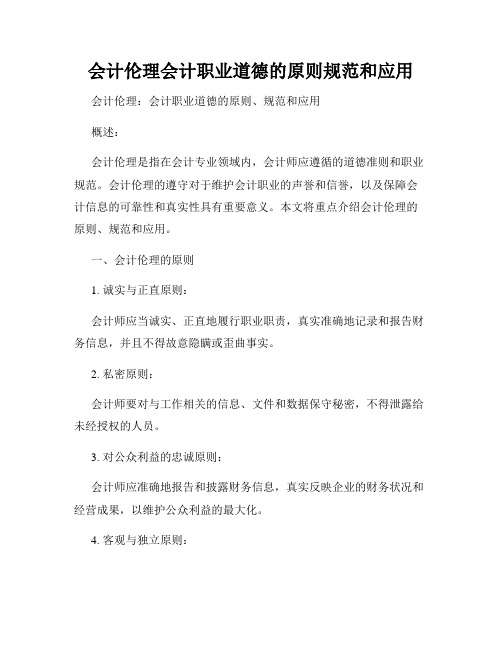
会计伦理会计职业道德的原则规范和应用会计伦理:会计职业道德的原则、规范和应用概述:会计伦理是指在会计专业领域内,会计师应遵循的道德准则和职业规范。
会计伦理的遵守对于维护会计职业的声誉和信誉,以及保障会计信息的可靠性和真实性具有重要意义。
本文将重点介绍会计伦理的原则、规范和应用。
一、会计伦理的原则1. 诚实与正直原则:会计师应当诚实、正直地履行职业职责,真实准确地记录和报告财务信息,并且不得故意隐瞒或歪曲事实。
2. 私密原则:会计师要对与工作相关的信息、文件和数据保守秘密,不得泄露给未经授权的人员。
3. 对公众利益的忠诚原则:会计师应准确地报告和披露财务信息,真实反映企业的财务状况和经营成果,以维护公众利益的最大化。
4. 客观与独立原则:会计师应保持客观、中立的态度,不受他人的压力和影响,遵守专业准则,不为私利而捏造、篡改或隐藏财务信息。
二、会计伦理的规范1. 会计师职业道德准则:会计师职业道德准则是全球会计师公认的伦理标准,用于指导和规范会计师的职业行为。
例如国际特许公认会计师联合会(ACCA)和美国会计师公认协会(AICPA)等机构都制定了职业道德准则。
2. 职业准则和行业规范:不同国家和地区都制定了一系列的职业准则和行业规范,旨在规范会计师的行为和职业责任。
例如,中国注册会计师协会(CICPA)发布了《注册会计师职业道德准则》等规范文件。
三、会计伦理的应用1. 保证财务信息的真实和可靠:会计师在编制和审核财务报表时,要遵循准确和真实的原则,确保财务信息的真实性和准确性,以反映企业的真实财务状况。
2. 防止潜在的欺诈行为:会计师应识别潜在的欺诈行为,及时采取措施防止并报告相关部门,确保企业财务活动的合法性和合规性。
3. 维护职业尊严和信誉:会计师应当遵守职业道德准则和规范,保持职业尊严和信誉。
他们应避免利用职务之便谋取私利,不得参与任何违法、不道德的行为。
4. 建立职业责任感和使命感:会计师应该秉持高度的职业责任心和使命感,将企业和公众的利益放在首位,以促进经济的繁荣和社会的发展。
大二财务会计知识点

大二财务会计知识点在大二阶段的学习过程中,财务会计是商科学生的一门重要课程。
财务会计作为管理会计的基础,为企业的经济决策提供重要的信息支持。
以下是大二财务会计的几个重要知识点,供同学们参考。
一、会计的基本概念财务会计是一种记录、分类、归纳和报告经济活动的系统。
它跟踪和记录公司的经济业务,为公司的经营决策提供重要的信息。
二、会计的核算对象会计的核算对象包括资产、负债、所有者权益、成本、收入和费用等。
通过核算对象的明确界定,可以对企业的经济活动进行有效分类和管理。
三、会计的记账原则会计的记账原则包括货币计量原则、实物计量原则、经济实质优先原则、会计等式平衡原则等。
这些原则为会计提供了基本准则,确保了会计信息的准确性和可靠性。
四、会计的核算方法会计的核算方法包括借贷记账法、凭证法、账户法等。
借贷记账法是财务会计最基本的核算方法,通过借贷双向记账的方式记录和反映经济业务的发生和变化。
五、财务报表财务报表是财务会计的核心成果,包括资产负债表、利润表、现金流量表和所有者权益变动表。
这些报表反映了公司在一定时期内的经济状况和经营绩效。
六、会计准则会计准则是在财务会计实践中规定的公认规则和原则,旨在确保财务信息的一致性和可比性。
国际财务报告准则(IFRS)和中国会计准则(CAS)是当前国际上通行的两大会计准则体系。
七、会计信息的分析会计信息的分析是财务会计中重要的环节,通过对公司财务报表的定量和定性分析,可以评估公司的盈利能力、偿债能力、营运能力和成长性等关键指标。
总结起来,大二财务会计的知识点涉及会计的基本概念、核算对象、记账原则和方法、财务报表、会计准则以及会计信息的分析等方面。
了解和掌握这些知识点,对于将来从事财务管理和决策分析工作的学生来说是至关重要的。
不管是在企业还是在个人生活中,财务会计都扮演着不可或缺的角色,帮助我们做出明智的经济决策。
因此,我们应该重视财务会计学科的学习,努力提高自己的财务知识水平。
武汉理工大学审计学期末复习题
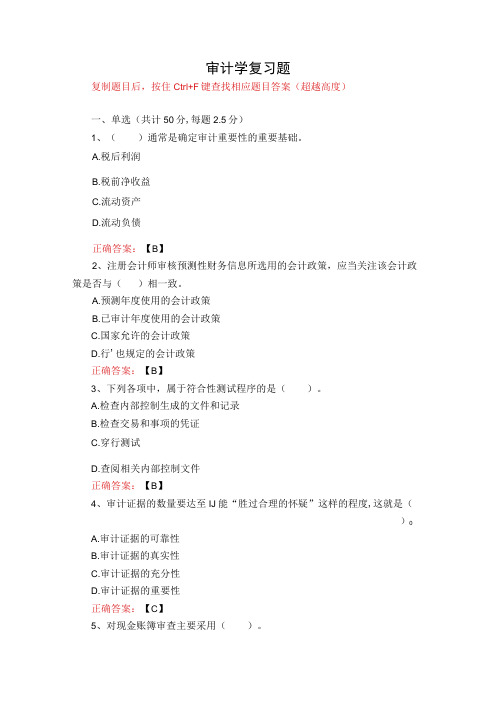
审计学复习题复制题目后,按住Ctrl+F键查找相应题目答案(超越高度)一、单选(共计50分,每题2.5分)1、()通常是确定审计重要性的重要基础。
A.税后利润B.税前净收益C.流动资产D.流动负债正确答案:【B】2、注册会计师审核预测性财务信息所选用的会计政策,应当关注该会计政策是否与()相一致。
A.预测年度使用的会计政策B.已审计年度使用的会计政策C.国家允许的会计政策D.行'也规定的会计政策正确答案:【B】3、下列各项中,属于符合性测试程序的是()。
A.检查内部控制生成的文件和记录B.检查交易和事项的凭证C.穿行测试D.查阅相关内部控制文件正确答案:【B】4、审计证据的数量要达至IJ能“胜过合理的怀疑”这样的程度,这就是()0A.审计证据的可靠性B.审计证据的真实性C.审计证据的充分性D.审计证据的重要性正确答案:【C】5、对现金账簿审查主要采用()。
A.查阅现金日记账B.明细账和总账核对C.编制清点表D.实地盘点正确答案:【A】6、会计报表如依照特殊编制基础编制,注册会计师应考虑会计报表标题或其附注是否己指明该编制基础,如未适当指明,注册会计师不能()。
A.发表无保留意见的审计报告B.发表保留意见的审计报告C.发表否定意见的审计报告D.无法表示意见正确答案:【A】7、资产评估时,对其中的有关流动资产应收款根据()考虑()因素,来确定重估价值。
A.账面价值,坏账损失B.实际价值,账龄C.可收回价值,坏账损失D.函证结果,账面价值正确答案:【A】8、下列各项中,不属于或有负债审计过程的是()。
A.向被审计单位管理当局询问B.获得律师申明书C.复核上期和审计期间税收结算报告D.复核被审计单位资产负债表日编制的会计记录正确答案:【D】9、下列管理当局对会计报表的认定中只与资产负债表要素有关的是()0A.存在或发生认定B.完整性认定C.权利和义务认定D.估价或分摊认定正确答案:【C】10、在风险导向审计中,审计人员应当根据审计风险及其要素与审计其他因素的关系决定审计的导向。
GAAP_Matching Principle 一般公认会计原则
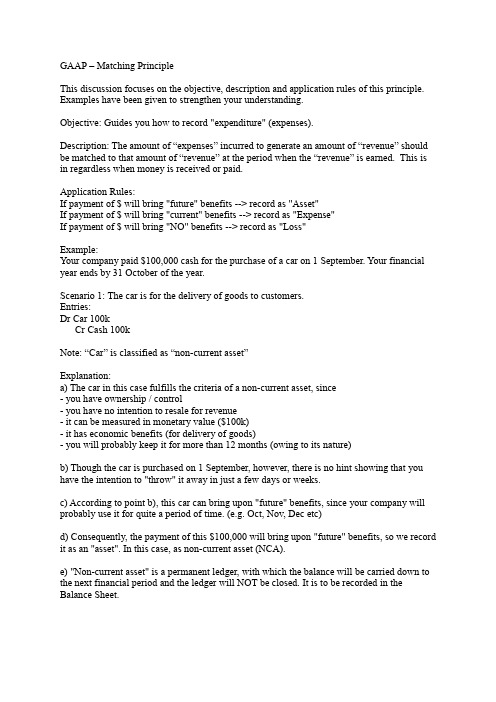
GAAP – Matching PrincipleThis discussion focuses on the objective, description and application rules of this principle. Examples have been given to strengthen your understanding.Objective: Guides you how to record "expenditure" (expenses).Description: The amount of “expenses” incurred to generate an amount of “revenue” should be matched to that amount of “revenue” at the period when the “revenue” is earned. This is in regardless when money is received or paid.Application Rules:If payment of $ will bring "future" benefits --> record as "Asset"If payment of $ will bring "current" benefits --> record as "Expense"If payment of $ will bring "NO" benefits --> record as "Loss"Example:Your company paid $100,000 cash for the purchase of a car on 1 September. Your financial year ends by 31 October of the year.Scenario 1: The car is for the delivery of goods to customers.Entries:Dr Car 100kCr Cash 100kNote: “Car” is classified as “non-current asset”Explanation:a) The car in this case fulfills the criteria of a non-current asset, since- you have ownership / control- you have no intention to resale for revenue- it can be measured in monetary value ($100k)- it has economic benefits (for delivery of goods)- you will probably keep it for more than 12 months (owing to its nature)b) Though the car is purchased on 1 September, however, there is no hint showing that you have the intention to "throw" it away in just a few days or weeks.c) According to point b), this car can bring upon "future" benefits, since your company will probably use it for quite a period of time. (e.g. Oct, Nov, Dec etc)d) Consequently, the payment of this $100,000 will bring upon "future" benefits, so we record it as an "asset". In this case, as non-current asset (NCA).e) "Non-current asset" is a permanent ledger, with which the balance will be carried down to the next financial period and the ledger will NOT be closed. It is to be recorded in the Balance Sheet.Scenario 2: (Same example applies but) The car is used as a gift for the lucky draw of a marketing activity for your company.Entries:Dr Marketing Expenses 100kCr Cash 100kNote: “Marketing expenses” is classified as “expense”Explanation:a) The car still fulfills all the criteria of a non-current asset as mentioned in Scenario 1.b) However, under this scenario, the car is purchased only as a "gift" of the lucky draw - which is a marketing activity of your company. The car "will not" and "cannot" be kept after the lucky draw, because it will be given as a gift to the winner (which surely will NOT be your company!).c) According to point b), this car can bring upon "current" benefits ONLY, since your company cannot "use" it for a period of time. (it can be used in the same manner as a "gift" only, e.g. a coupon!)d) Consequently, the payment of this $100,000 will bring upon "current" benefits, so we record it as "expense". In this case, as marketing expenses.e) "Expense" is a temporary ledger, which is to be closed by the end of the financial year and recorded in Income Statement.Final Comment:See the differences? Though the same amount of $ is paid (in this e.g. $100k) and the same item is purchased (in this e.g. the car), however because the duration of benefits that will bring upon by this item (or amount of $) differs (scenario 1 --> long term; scenario 2 --> current), then this same amount of $ will be recorded differently (scenario 1 --> as NCA; scenario 2 --> as expenses).This is exactly what the "matching principle" of the GAAP tells us. It guides us how to record an "amount of expenditure", based on how long the company can benefit from the relative amount of payment.Though this is NOT all!The matching principle also tells us "when" we should record an amount of expenses -- it is when revenue is generated due to this amount of expenses, therefore, comes the "adjustment". In short, matching principle guides us how and when to record expenditure.。
会计英语词汇

会计英语词汇 Prepared on 22 November 2020C h a p t e r 1 Accounting 会计,会计学Accountant 会计师,会计人员Accounting information 会计信息Financial data 财务数据Business 企业,经营,商业,业务Business transaction 经济业务,经济交易Enterprise 企业Economic information 经济信息Business organization 经济组织Financial activity 财务活动,筹资活动Profitability 获利能力,盈利能力End product 最终产品Creditor 债权人Performance 业绩Favorable 有利的Unfavorable 不利的Accounting system 会计系统,会计制度Financial condition 财务状况Investor 投资人Result of operations 经营成果Financial report 财务报告To make decision 制定决策Accounting principles 会计原则Business activity 经济活动Accounting concepts 会计概念Financial accounting 财务会计Economic unit 经济单位Owner 业主,拥有者Governmental agency 政府机构Generally accepted accounting principles 公认会计原则Employ 采用Prepare 准备,编制Annual report 年度报告Stockholder 股东Audit 审计,审查,查帐Auditing 审计,审计学Accounting records 会计记录Public accountant 公共会计师Fairness 公正性,公允性Reliability 可靠性Periodic audit 定期审计Corporation 股份有限公司Internal auditor 内部审计人员Cost accounting 成本会计Cost data 成本数据Management accounting 管理会计Selling price 销售价格Management advisory service 管理咨询服务Management service 管理服务Tax accounting 税务会计Tax returns 纳税申报单,税单Budgetary accounting 预算会计International accounting 国际会计International trade 国际贸易Not-for-profit accounting 非盈利组织会计Not-for-profit organization 非盈利组织Social accounting 社会会计Measurement 计量Chapter2Accounting practice 会计实务Accounting theory 会计理论Decline 方针,指南Assumption 假设Business entity 经济主体Accounting entity 会计主体Economic activity 经济活动Bookkeeping 簿记Double-entry bookkeeping system 复试记账系统Entry分录,记录Single proprietorship独资Partnership合伙Accounting purpose会计目的Separate entity独立主体Asset资产Going-concern持续经营Historical cost历史成本Current market value 当前市场价值Accounting period会计期间Stable-monetary-unit货币计量单位Objective principle客观性原则Operating result经营成果Cost principle成本原则Actual cost实际成本Book value账面价值Equivalent当量,约当量Depreciation折旧Consistency principle一贯性原则Accounting method会计方法Financial statement 财务报告Comparability可比性Materiality principle重要性原则Conservatism principle谨慎性原则Revenue收入Expense费用Cost of goods商品成本Net income净收入Net loss净损失Accrual-basis 权责发生制Cash-basis 现金收付制Journal 日记账Realization principle 实现原则Matching principle 配比原则Recognize 确认Transfer转让,转帐,过户Income statement收益表,损益表Full-disclosure principle充分揭示原则Chapter3Accounting element会计要素Accounting equation会计等式Liability负债Owner s’ equity业主权益,所有者权益Current asset长期资产Long-term asset长期资产Operating cycle 经营周期Bank deposit 银行存款Short-term investment短期投资Long-term investment长期投资Accounts receivable应收账款Note receivable应收票据Prepayment 预付款项Inventory 存货Fixed asset 固定资产Plant and equipment 厂房和设备Intangible asset 无形资产Store fixtures店面装置Office equipment办公设备Delivery equipment运输设备Creditors’ equity债权人权益Obligation责任,义务Debt债务Current liability流动负债Long-term liability长期负债Short-time loans payable应付短期贷款Long-term loans payable长期应付贷款Notes payable应付票据Accounts payable应付账款Accrued expense应计费用Bonds payable应付债券Long-term accounting payable长期应付账款Interest 股份,利息Claim 要求权Net assets 净资产Capital资本Stockholder’s equity 股东权益Cost of goods sold 商品销售成本Administrative expenses 管理费用Selling expenses销售费用Financial expense 财务费用Occur 发生Dividend payable 应付股利Retained earnings留存收益Chapter4Classification分类,分级Day-to-day 随时Account title 账户名称Ledger 分类帐Debit side 借方Credit side 贷方Charge借记,收取费用Memorandum 摘要,备忘录Insert 插入,嵌入,写入Cash on hand 库存现金subgrouping子目,细目supplies 物料用品prepaid expenses 预付费用face value 面值check 支票bank draft 银行汇票money order 汇款单debtor 债务人bearer 持票人salaries payable 应付工资taxes payable 应付税费interest payable 应付利息long-term notes payable 长期应付票据mortgage payable 应付抵押借款bonds payable 应付公司债券drawing提款income summary收益汇总professions fees职业服务费commissions revenues 佣金收入interest income利息收入chart of accounts账户一览表executive salaries主管人员薪金office salaries办公人员薪金sales salaries销售人员薪金prepaid rent预付租金accumulated depreciation累计折旧depreciation expense折旧费用sales销售收入sales returns and allowance销售退回与折让purchases returns and allowance购买退回与折让Chapter5Accounting cycle会计循环Accounting procedures会计程序,会计方法Trial balance试算平衡表Post-closing trial balance结算后试算平衡表Journalize 做分录,记账Post to the ledger过入分类帐Assemble汇集Work sheet工作底表Adjusting entry调整分录close结账,结清,关闭ledger accounts分类账户general ledger总分类帐two-column account两栏式账户source document原始凭证check stub支票存根journal日记帐journal entry日记帐分录records(book) of original entry原始记录簿transcribe抄录post过账,誊帐manually手工的chronological按时间顺序的enter登记,计入general journal普通日记账special journal特殊日记帐sales journal销售日记帐purchases journal购买日记帐cash receipts journal现金收入日记帐cash disbursements journal现金支出日记帐division of labor分工Chapter6Adjusting procedures调整程序Accrual(basis) accounting权责发生制Align调整,使成一线,(转做)使一致Apportion(按比例)分配,摊配Accrue自然积累(如利息等),计提Outlay支出Expire期满,耗尽,失效Insurance expense保险费用Prepaid insurance 预付保险费Supplies expense物料用品费Supplies on hand在用物料Subscription预订Deferred credit递延贷项Accrued salaries payable应计应付工薪Accrued revenue应计收入Closing entry结账分录Closing procedure结账程序Temporary account临时性账户,名义账户,虚账户Permanent account 永久性账户,实账户Withdrawals提款Statement of cash flow现金流量表Financial position财务状况Portray描绘Dispose处理Inflows流入Outflows流出Chapter7Working paper工作底稿Adjusted trial balance调整后试算平衡表Cross-reference交叉参考Occasion需要,机会,工作场合Salaries accrued应计薪金Combine结合,联合Extend(会计)将数字转入。
美国GAAP和IFRS的主要区别
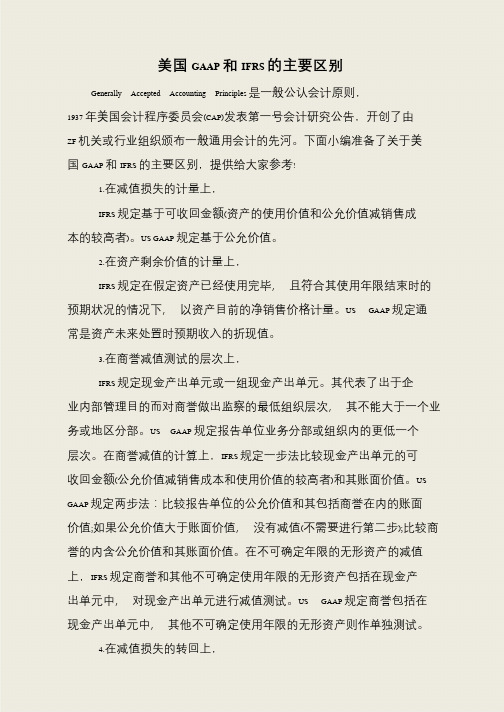
美国GAAP 和IFRS 的主要区别Generally Accepted Accounting Principles 是一般公认会计原则,1937 年美国会计程序委员会(CAP)发表第一号会计研究公告,开创了由ZF 机关或行业组织颁布一般通用会计的先河。
下面小编准备了关于美国GAAP 和IFRS 的主要区别,提供给大家参考!1.在减值损失的计量上,IFRS 规定基于可收回金额(资产的使用价值和公允价值减销售成本的较高者)。
US GAAP 规定基于公允价值。
2.在资产剩余价值的计量上,IFRS 规定在假定资产已经使用完毕﹐且符合其使用年限结束时的预期状况的情况下﹐以资产目前的净销售价格计量。
US GAAP 规定通常是资产未来处置时预期收入的折现值。
3.在商誉减值测试的层次上,IFRS 规定现金产出单元或一组现金产出单元。
其代表了出于企业内部管理目的而对商誉做出监察的最低组织层次﹐其不能大于一个业务或地区分部。
US GAAP 规定报告单位业务分部或组织内的更低一个层次。
在商誉减值的计算上,IFRS 规定一步法比较现金产出单元的可收回金额(公允价值减销售成本和使用价值的较高者)和其账面价值。
US GAAP 规定两步法:比较报告单位的公允价值和其包括商誉在内的账面价值;如果公允价值大于账面价值﹐没有减值(不需要进行第二步);比较商誉的内含公允价值和其账面价值。
在不可确定年限的无形资产的减值上,IFRS 规定商誉和其他不可确定使用年限的无形资产包括在现金产出单元中﹐对现金产出单元进行减值测试。
US GAAP 规定商誉包括在现金产出单元中﹐其他不可确定使用年限的无形资产则作单独测试。
4.在减值损失的转回上,。
一般会计原则
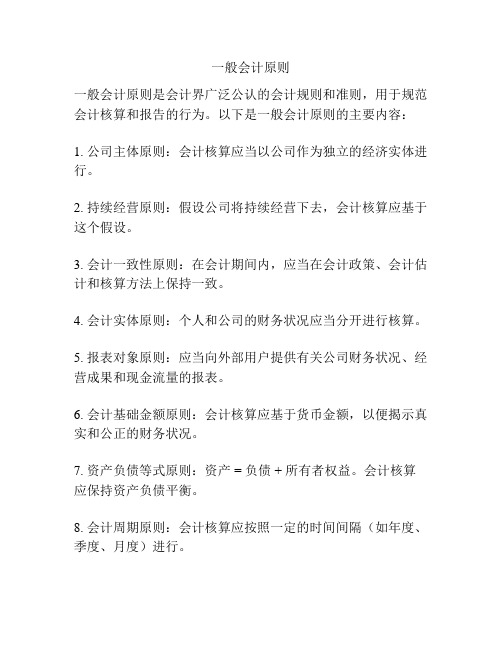
一般会计原则
一般会计原则是会计界广泛公认的会计规则和准则,用于规范会计核算和报告的行为。
以下是一般会计原则的主要内容:
1. 公司主体原则:会计核算应当以公司作为独立的经济实体进行。
2. 持续经营原则:假设公司将持续经营下去,会计核算应基于这个假设。
3. 会计一致性原则:在会计期间内,应当在会计政策、会计估计和核算方法上保持一致。
4. 会计实体原则:个人和公司的财务状况应当分开进行核算。
5. 报表对象原则:应当向外部用户提供有关公司财务状况、经营成果和现金流量的报表。
6. 会计基础金额原则:会计核算应基于货币金额,以便揭示真实和公正的财务状况。
7. 资产负债等式原则:资产 = 负债 + 所有者权益。
会计核算应保持资产负债平衡。
8. 会计周期原则:会计核算应按照一定的时间间隔(如年度、季度、月度)进行。
9. 收入确认原则:收入应当在获得经济利益的同时确认,而不论何时收到现金。
10. 成本原则:会计核算应当基于成本原则,即确认和计量资产和负债应基于其购买或生成时的成本。
这些原则为会计核算提供了准则,确保了会计信息的准确性、可靠性和可比性。
财务会计术语中英文对照

accelerate ddepreciati on 加速折旧法account 帐户、会计科目accounting cycle会计循环accounting changes会计变动accounting income会计收益accounting policies会计政策accountingprinciplesboard(AP B)会计原则委员会accountin gstandards executive coomittee 会计准则执行委员会accountin g trendsand technique 会计趋势与技术accountsreceivables应收帐款accrual basis 权责发生制accruedexpenses应付费用accrueditems应计项目accruedrevenues应收收入accumulateddepreciation累计折旧acid-test ratio 酸性测试比率presentvalue现值markup再加价additionalmarkupcancellati on 再加价取消aditionalpaid-incapital资本公积adjusting调整aging oftheaccounts approach 帐龄分析法allowancefordoubtfulaccounts坏帐准备allowancemethod备抵法allowanceto reduceinventory to market 存货跌价准备allowance to reduce short-term investments to market 短期投资跌价准备American Accountin gAssociati on(AAA)美国会计学会American Institete of Certified PublicAccounta nts(AICP 美国会计师协会amortization摊销an annuity due 到期年金终值amount of anordinary annuity 普通年金终值analysis of long-term solvency 长期偿债能力分析analysis of returnon investmen 投资报酬分析analysis of short-term liquidity 短期偿债能力分析announce ment date 认股权宣告日annualeffective tax rate 全年有效税率annuity年金annuitydue到期年金annuitymethod年金法antidilutiv e effect 反稀释效果APBopinion & statement s APB发布的意见书及声明书appraisalsystem评价法appraisalvalue评定价值appropriaed指拨appropriatedretained earnings 拨定留存收益assetexpenditure资本支出assets资产associating cause and effect 因果关系直接配属attribution摊计auditor'sreport审计报告authorized capital stock 核准发行股份available for sale 备供出售者available-for-sale securities 备供出售证券averagecollection period 帐款收回平均天数average days tosell the inventory 存货周转平均天数bad debtexpense坏帐费用balancesheet approach 资产负债表法bankoverdraft银行透支bankreconcilia tion 银行往来调节表bankstatement对帐单baseinventory基期存货base year基期basicaccountin g equation 会计基本方程式basicprinciples基本原则bearer bonds 息票公司债beneficiary受益人betterment改良billingsonconstruction in process 预收工程款bonds payable 应付公司债bonus and profitsharing plan 员工奖金及分红bookvalue method 帐面价值法bookvalue ofnet assetsacquired股权净值callpremium收回溢价call price赎回价格callprovisions收回条款callable bonds 可收回公司债callablepreferred stock 可收回优先股capitalexpenditure资本支出capitallease资本租赁capitalstock股本capitalstocksubscribe d 已认购股份capitalsurplus资本公积capitalization of interest 利息资本化carryingvalue帐面价值cashdiscount现金折扣cashdividends现金股利cashequivalent s 现金等价物cash flowsfrom operation activities 营业活动的现金流量cash overand short现金短溢certificates ofdeposit定存单changefunds找零金changesinaccountin g estimate 会计估计的变动changes inaccountin g 会计原则变动changes inreporting entity 编制报表主体变动consistency一致性claim请求权closedcorporatio ns 非公开发行公司closing结帐collectionmethod收现法commonstock普通股common stocksubscribe d 已认普通股股本common-size financialstatement s 共同比财务报表comparability比较性comparativeanalysis比较分析comparativestatements比较报表compensatory stockoption plan 酬劳性认股计划completedperfoman ce method 全部履行法completed-contract method 全部完工法complexcapital structure 复杂资本结构compound interestmethod复利法comprehensive approach 全面改革法computersoftware costs 电脑软件成本condensed income statement 简明损益表conservatism稳健原则consignee承销人consignment-in承销品consignment-out寄销品consignor寄销人construction inprocess在建工程contingencies或有事项contingentliabilities或有负债continuityconventio n 持续经营惯例contraaccount抵减科目contributed capital投入资本controlling account统制帐户conventions惯例convertibl e bonds 可转换公司债convertibl epreferred stock 可转换优先股copyrights 著作权,版权cost addmarkup contract 成本加价合约costallocation method 成本分摊法costdepletion method 成本折耗法cost flowassumptio n 成本流动假设cost index成本指数costmethod成本法cost of goodsmanufact ured 产成品成本cost priociple; historicalcost principle 历史成本原则costrecovery method 成本回收法cost-benefit constraint 成本效益限制costs ofconstructi on 工程成本比例法costs ofissuing bonds 公司债发行成本cost-to-cost method 工程成本比例法coupons兑换券covenants债务条款credit贷credit card sale 信用卡销货creditratings信用评级crossreference交叉索引cumulative deficit累积亏损cumulativ e effect 累积影响数cumulativ e effectadjustmen t 当期调整法cumulativ e effect of change inaccountin g principle 会计原则变动累积影响数cumulativ e effect of changesin accountin g 会计原则变动累积影响数cumulativ epreferred stock 累积优先股currentadjustmen t 当期调整法currentassets流动资产currentliabilities流动负债currentmaturitiesof long-term debts 长期负债一年内到期部分currenttatio流动比率currenttax expense(b enefit)当期所得税费用(利益)date ofannoucement宣告日date ofdeclaratio n 股利宣告日date of expiration 过期失效日date ofex-right除权日date of payment 股利发放日date of record 股权登记日debenture bonds 无担保公司债debit借debit andcreditrules借贷法则debtsecurities债务证券debt to stockhold ers' equity 负债对股东权益比率debt tototalassetsratio负债比率decision usefulness 决策有用性deferredannuity递延年金deferredcharge递延借项deferredcompensa tion cost 递延酬劳成本deferredcredits递延贷项deferredgross profit 递延销货毛利deferreditems递延项目deferredmethod递延法deferredpayment contract 递延付款合约deferredrecognition递延认列deferred tax asset 递延所得税资产deferredtax liability 递延所得税负债depletableassets递耗资产depletion折耗deposit intransit在途存款depreciab ale assets 折旧性资产depreciable cost折旧成本depreciation base折旧基础depreciationexpense折旧费用derivativefinancialinstrumen ts 衍生性金融商品development costs开发成本dicision usefulness 决策的有用性dilutiveeffect稀释作用directfinancing lease 直接融资租赁direct method 直接冲销法directmethod直接法direct pricing 直接评价法directwrite-off method 直接冲销法discontinuedsegment停业部门discounton bonds payable 公司债折价discounton notes payable 应付票据折价discounton notes receivable 应收票据折价discounted presentvalue折现值discounting notes receivable 应收票据贴现dishonore d notes receivable 拒付票据、催收票据disposaldate处分日distributions to owners 分配给业主dividendpay-out ratio 股利支付率dividendrevenue股利收入dividend yield ratio 股利收益率dollar-valurLIFO retail method 金额后进先出零售价法dominantindustry segment 主要产业部门donatedassets受赠资产donatedtreasury stock 受赠的库藏股票double-declining-balance method 双倍余额递减法double-entrybookkeeping复式簿记dualpresentations双重表达dueprocess审慎程序dynamicstatements动态报表earingsper share每股盈余earlyextinguishment提前偿付earned已赚得earnedsurplus盈余公积earning盈余economicentityassumptio n 经济主体假设economicincome经济所得economicsubstance over legal form 经济实质重于法律形式effective interestrate method 实际利率法effectiverate有效利率effective yield 实际利率、市场利率、有效收益率efficient markethypothesi s 效率市场假说efforts-expended method 工时进度比例法emergingissues task force 紧急问题处理小组employeediscount员工折扣employee stockoption plan 员工认股计划equitymethod权益法equitysecurities权益证券equivalentpercentage of interest 约当持股比例estimateditems估计项目estimatedliabilityunder warranties 估计产品保证负债estimatedresidualvalue估计残值excessearnings approach 超额盈余法exchangable可交换性exchangerate effects 汇率变动的影响ex-dividenddate除息日executory contract 待执行合同executorycosts履约成本exerciseof call privilege 行使赎回权expectedreturn on plan assets 退休金资产预期报酬expense warrantyaccrual method 保证费用计提法warranty approach 保证费用计提法expirationdate of the rights 认股权行使截止日expiration of return-right method 退货权逾期法exploration costs勘探成本ex-rightstock除权股extinguishment ofdebt债务清偿extraordinarygain(loss)非常损益extraordinaryrepairs大修faceamount面值face rate票面利率feedbackvalue回馈价值financialaccounting fundation 财务会计基金会financial accountin gstandards advisory council 财务会计准则咨询委员会financial accountin gstandards board(FA SB)财务会计准则委员会financialcapital财务资本flexibility财务弹性financialincome财务所得financialinstruments理财工具financialleverage index 财务杠杆指数financial mobility 财务机动性financingactivities理财活动finishedgoods inventory 产成品存货first-infirst-out先进先出fixedassets固定资产flexibility弹性floating浮动floor市价下限flow流量footnotes附注four-columnbank reconcilia tion 四栏式银行往来调节表fractionalyear depreciati on 不满一年的折旧计算franchise revenue 加盟特许收入franchisee加盟员franchises特许权franchisor加盟主free onboarddestinatio n 目的地交货free on boardshipping point 起运点交货full costing 全部成本法fulldisclosure principle 充分披露原则full-cost approach 全部成功法fully dilutedearnings per share 完全稀释每股盈余funds基金funds statement 资金状况表future amount ofan annuity due 到期年金终值future amount of anordinary annuity 普通年金终值futures期货gaincontingencies或有利得gain(loss)onconversio n of bonds 公司债转换(损)益gain(loss) on sale ofshort-term investmen ts 出售短期投资利益(损失)general journal 普通日记帐general purchasin g poweraccountin g 一般购买力会计general purposefinancial statement 一般目的财务报表generally accepted accountin gprinciples (GAAP)一般公认会计原则going concern(c ontinuity)assumptio n 持续经营假设goods intransit在途商品goodwill商誉grant date给予日greenmail绿色信函grossmethod总额法grossprofitmethod毛利率法guarantee d bonds 保证公司债guaranteed residualvalue保证残值held to maturity 持有至到期日held-to-maturity securities 持有至到期日证券high ratio of returnedmerchand ise to 高退货率的销货horizontalanalysis水平分析hostiletakeover恶意并购idealism理想性identifiable intangible assets 可明确辨认的无形资产imapairment of value 价值的减损impairment of assets 资产价值减损implicit rate computedby the lessor 出租人的隐含利率improvements改良imputed interest rate 隐含利率,设算利率inceptionof the lease 租赁开始日incomebeforeincometaxes税前净利incomestatementapproach损益表法incomesummary本期损益incometax allocation 所得税分摊incometax benefit 所得税利益incometaxes payable 应付所得税incometaxes withheld 扣缴所得税income(lo ss) from continuing operation 持续经营部门损益income(lo ss) from discontinued operation 停业部门损益increment alborrowing rate 增额借款利率incremental direct costs 增额直接成本incremental method增额法individualitem approach 个别比较法inducedconversion引诱转换industrypeculiarities行业特性industrysegments产业部门inflationaccountin g 通货膨胀会计infrequency ofoccurrence不常发生initial direct cost 原始直接成本initialfranchise fee 原始权利金installment accounts receivable 分期应收帐款installmen t sales 分期付款销货installment sales method 分期付款法in-substancedefeasance of debt视同清偿intangibleassets无形资产interestcosts利息成本interestondiscount贴现息interestrate swaps利率交换interest-bearingnote附息票据interimdebt中期负债internalauditing内部稽核internaldirect costs 内部直接成本internally developed 内部自行发展interperio d incometax allocation 跨期所得税分配interpolation插补法intraperiod incometax allocation 同期所得税分配inventorymethod盘存法inventory turnover 存货周转率investeme nt tax credit 投资租税抵减的处理investmen t revenue-discontinued operation 停业部门投资收益investmen t revenue-extraordin ary 非常投资收益investment revenue-ordinary 一般投资收益issuance date 认股权发行日issuancefor cash现金发行issue papers 待研究问题通报、问题报告issuedcapital stock 已发行股份issues in accounting education 会计教育问题研究journal 日记簿、分录簿journalizing分录junk bond垃圾债券just-in-timeinventory system 即时存货系统landimprovem ents 土地改良物largestock diveidend 大额股票股利last-infirst-out后进先出leaseterm(duration)租赁期间leasedassetundercapitalleases租赁资产leaseholdimprovements租赁改良legalcapital法定资本legal form法律形式leverage财务杠杆leveragebuyouts融资购并leverageleases杠杆租赁LIFO liquidatio n 后进先出存货的减少lifo reserve 后进先出存货准备line ofbusiness主要行业liquidity流动性listedcorporations上市公司long-termcapital to fixed assets 长期资金对固定资产比率long-terminvestments长期投资long-termliabilities长期负债long-termnotes payable 长期应付票据long-termoperation al assets 长期营业用资产losscontingencies或有损失loss fromdiscountin g of notes 票据贴现损失loss fromlong-termcontracts工程损失loss onimpairme nt 价值减损损失lower of cost ormarket method 成本与市价孰低法lump-sumpurchase整批购买managerialaccountin管理会计manufacturing cost制造成本marginaltax rate边际税率markdowncancellation减价取消marketmethod市价法marketvaluemethod市价法markup加价matchingprinciple配比原则materiality重要性maturityvalue到期值measurement date衡量日merchandiseinventory商品存货ity可衡量性mislead误导monetary assets 货币性资产monetary items 货币性项目moneycapital gain 货币资本利得mortgage bonds 抵押公司债movingaverage移动平均multiple-items approach 混合商品法multiple-pool method 多项组合法multiple-stepformat多步式multiple-stepincome statement 多步式损益表netaccounts receivable 应收帐款净额netadditionalmarkup净再加价netmarkdown净减价netmethod净额法netrealizablevalue method 净变现价值法neutrality中立性nominalaccount虚帐户rate名义利率noncompensatory plans 非酬劳性计划noncompe nsatory stockoption plan 非酬劳性认股计划noncumul ativepreferred stock 非累积优先股noninterest-bearing note 不附息票据nonmonet ary items 非货币性项目nonpartici patingpreferred stock 非参加优先股noparvaluestock无面额股normalshrinkage正常损耗notesreceivabledishonored(past due)拒付应收票据notesreceivables应收票据NSF (notsufficient fund)存款不足支票number ofcompoundingperiods复利次数obligations undercapital leases 应付租赁款off-balance-sheet financing 资产负债表外融资operatingcycle营业周期operatinglease营业租赁operational assets营业资产option选择权ordinaryannuity普通年金originalsellingprice原始售价output measures 产出单位比例法outstanding capital stock 流通在外股份outstandin g checks 未兑现支票paid-incapital投入资本par value面额par valuemethod面额法par valuestock有面额股participatingpreferred stock 参加优先股percentageapproach百分比法percentagedepletion method 百分比折耗法percentag e of grossprofit method 毛利百分比法percentag e-of-completio n method 完工比例法percentag e-of-receivables approach 应收帐款百分比法percentage-of-sales approach 销货百分比法periodexpense期间费用periodicinventory system 定期盘存制permanent account实帐户permanent difference 永久性差异perpetualinventory system 永续盘存制petty cash零用金physicalcauses物质因素physical inventory 实地盘存制plantassets厂房设备point ofsale销货点pooling ofinterests method 权益结合法post-balancesheetevents期后事项posting过帐predictivevalue预测价值preemptiv e rights 优先认股权preferredstock优先股prepaidexpenses预付费用prepaidincome taxes 预付所得税preparingtrialbalance试算presentamount现值presentvalue ofan annuity due 到期年金现值present value of anordinary annuity 普通年金现值priceindex approach 物价指数法price-earningsratio(p/eratio)市盈率primaryearnings per share 基本每股盈余principal本金priorperiodadjustmen t 前期损益调整probable很有可能product warranty 产品售后服务保证pro-formaamounts拟制资料propertyrights财产权property,plant andequipment厂房设备proportionalmethod比例法proportionalperforman ce method 比例履行法、purchasecommitments进货合约purchasediscount进货折扣purchaseretuen and allowance 进货退回及折让quickassets速动资产quickratio速动比率rate ofreturn ontotal assets 总资产报酬率ratioanalysis比率分析rawmaterialinventory原料存货reacquisition price收回价格readilydetermina ble fair value 具有明确的公平价值readymarketability变现性realaccount实帐户real estate lease 不动产租赁reasonably possible有可能receivables应收款项receivable s turnover 应收帐款周转率recover回收recoverab ility test 可回收性测试refinancing再融资relatedpartytransactio ns 关系人交易relative salesvalue method 相对售价法relevance相关性reliability可靠性realizable可实现realized已实现remote极少可能repairsandmaintenan ce 修理与维护repaymentat maturity 到期直接偿付replacement cost重置成本replacement method重置法replenishof petty cash 零用金的拨补representationalfaithfulness忠实表达researchand developm ent costs 研究开发支出(成本)researchmonograph研究论丛reserve准备value残值restoratio n costs 回复原状成本retailinventory method-FIFO 先进先出成本零售价法retailmethod零售价法retainedearnings留存收益retroactiverestateme nt 追溯重编法return of capital 资本的退回return oninvestmen t 投资报酬率revenue(expense)expenditure收益支出revenuefromlong-termcontracts工程收入revenueprinciple;revenuerecognition principle 收入认列原则revenuescollectedinadvance预收收入reversingentry转回分录risk free无风险sales andleaseback售后租回salesdiscount销货折扣discount not taken 顾客未取得折扣salesreturn and allowance 销货退回与折让sales withbuyback agreement 附买回合约的销货sales withhigh rates of return 高退货率的销货salvagevalue残值secondarycapital market 次级资本市场secretreserve秘密准备secured bonds 附担保公司债securities and exchangecommissi on(SEC)证券交易委员会seethrough看穿segmentreporting分部报告self-constructed assets自建资产servicecosts服务成本servicehours method 工作时间法servicelife耐用年限short-terminvestments短期投资significant industry segment 重要产业部门significant influence 重大影响力simplecapital structure 简单资本结构simpleinterest单利single-stepformat单步式single-stepincome statement 单步式损益表sinkingfund method 偿债基金法sinkingfunds偿债基金smallstock dividend 小额股票股利softwareproductio n costs 软件生产成本sourcedocuments原始凭证specialcolumn专栏special journal 特种日记帐specificidentification个别认定specifically identifiabl 可个别辨认standardcost标准成本standardcost system 标准成本法statedcapital法定资本statedinterestrate票面利率stated rate名义利率statedvalue设定价值statementof cash flows 现金流量表statement of changesin financial 财务状况变动表statement of sources and applications of funds 资金来源运用表statement s of financialaccountin g 财务会计概念公报statement s of financial accounting standards and interpretat 财务会计准则公报及公报的解释staticanalysis静态分析staticstatements静态报表statutorydepletion method 法定折耗法stockdividends股票股利stockoption plan 员工认股计划stockrights认股权stocksplits股票分割stock warrants 认股权、认股证stockholders' equity股东权益stockholders' equity to fixed assets 股东权益对固定资产比率stockholders' equityto totalassets权益比率straight-linemethod直线法structuralanalysis结构分析subscribe d stock 已认购股本subscriptionsreceivable应收股款subsequent events期后事项subsidary accounts 明细帐、子目successfulefforts approach 勘探成功法sum-of-the-years'-digits method 年数合计法supermajority vote 绝大多数票决supplementaryinformation补充资讯supportingschedules补充附表swaps交换权systemma tic andrational allocation 系统而合理的分摊tax credit 所得税抵减taxable amount 应课税金额taxableincome课税所得taxesrefundreceivable应退税额technical bulletins 技术性公报technological feasibility 技术可行性temporaryaccount虚帐户temporarydifference s 暂时性差异temporaryinvestment临时投资theory理论timeperiodconventio n 会计期间惯例timevalue of the money 货币时间价值timeliness及时性times-interest-earned ratio 利息保障倍数timing difference 时间性差异total asset turnover 总资产周转率tradediscount商业折扣trade-ins抵换trademarks商标权trading securities 经常交易证券transactionapproach交易法treasurystock库藏股treasurystock method 库藏股票法trendanalysis趋势分析trial anderrormethod试误法trialbalance试算表troubleddebtrestructuri ngs 财务困难债务整理true nopar stock 无面值股票trustee信托人twotransactions concept 两项交易观念unaffiliated customer 非关系企业的客户unappropriated未指拨underlyingassumptions基本假设understandability可理解性unearnedfranchise fees 预收加盟特许收入unearnedinterest revenue 未实现利息收入uniformity统一性unit lifo method 单位后进先出法unit pricing 单位评价法unit-of-measure assumptio n; monetaryunit assumptio 货币计量假设units ofproductio n method 生产数量法units-of-output method 生产数量法unlisted or over-the-counter corporatio ns 上柜(非上市)公司unrealized capital 未实现资本unrealizedcapital gains or losses 未实现资本增值或损失unrealized gain on market value recoveryof short-term investmen ts 短期投资未实现市价回升利益unrealizedgain or loss 未实现损益holdinggain or loss 未实现持有损益unrealized loss onlong-term investmen ts 长期投资未实现跌价损失unrealized loss onshort-term investmen ts 短期投资未实现跌价损失unusual innature性质特殊valuationaccount评价科目variable costing 变动成本法verifiability可验证性verticalanalysis垂直分析vestedrights既得权利visualinspectionmethod目视法wateredstock掺水股本weightedaverage加权平均weighted-averageamount ofaccumulatedexpenditu res 累积支出的平均数and where-gone statement 资金来源与用途表withrecourse有追索权withholding代扣款项withoutrecourse无追索权work inprocess inventory 在产品存货workingcapital营运资金workingcapitalratio流动比率workingmodel作业模型worksheet method 工作底稿法years-of-service method 预期服务年数法。
会计九大原则

会计九大原则会计九大原则,也叫会计准则,是会计界公认的准则,即对会计核算以及财务报表的编制和呈现等方面的规定和要求。
这些准则为财务信息的标准化和稳定性提供了基础,并且对了解企业的财务状况和经济实力的评估,以及与其他企业的比较和竞争分析都有着重要的意义。
下面是会计九大原则的具体内容:1.谨慎原则:指会计人员在工作中应该保持审慎、谨慎的态度,不能对业务随意判断或作出随意的决定。
因为财务造假将会对投资者、债权人、员工和经营者带来巨大的危害。
2.实质重于形式原则:指推行会计准则要关注事物的实质,而不是片面迷信于表面的形式。
实质重于形式原则是会计业内最为重要的原则之一。
3.货币计量原则:指所有财会核算都基于货币计量,其他非货币性的经济资产或负债须转化为相应的货币量,以便能够登记在账目中。
在计算企业资产总值和营利情况时,必须以货币的方式计算。
5.周期性报表原则:指财务报表应制成年度、半年度或季度报表,如有必要,有的公司还需编制月度报表,以便及时了解企业的财务状况。
这样,公众对于标准的会计周期一目了然,有助于保证企业的财务信息顺畅的传播。
6.持续经营原则:指假设一个公司将永久地继续运营下去,并且其财务报表也应反映出公司在未来一段时间内的经营情况。
因此,企业的财务报表必须确保反映其持续经营的真实状况。
7.一致性原则:指会计核算应该在某种程度上保持一致,以便于被人们比较和分析。
一致性原则是会计核算的基础,它有助于保证企业的财务报表的可比性和准确性。
8.充分揭示原则:指在编制财务报表时,应遵循真实、完整、准确的原则,透露企业财务信息的详细情况和核算过程,以保障企业财务报表的有效性和可信度。
9.披露原则:指会计人员不得隐瞒所有与财务信息有关的情况,并必须全面公开企业财产、财政状况以及利润等资讯。
这样的会计披露有助于投资者做出正确的投资决策。
一般会计原则和财务信息质量要求
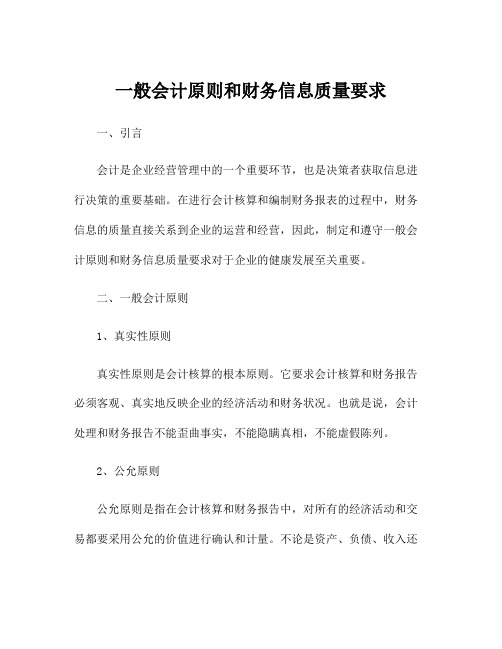
一般会计原则和财务信息质量要求一、引言会计是企业经营管理中的一个重要环节,也是决策者获取信息进行决策的重要基础。
在进行会计核算和编制财务报表的过程中,财务信息的质量直接关系到企业的运营和经营,因此,制定和遵守一般会计原则和财务信息质量要求对于企业的健康发展至关重要。
二、一般会计原则1、真实性原则真实性原则是会计核算的根本原则。
它要求会计核算和财务报告必须客观、真实地反映企业的经济活动和财务状况。
也就是说,会计处理和财务报告不能歪曲事实,不能隐瞒真相,不能虚假陈列。
2、公允原则公允原则是指在会计核算和财务报告中,对所有的经济活动和交易都要采用公允的价值进行确认和计量。
不论是资产、负债、收入还是费用,在确认和计量时都要遵循公允原则,保证会计信息的公允性和可比性。
3、连续性原则连续性原则是指在会计期间连续运营假设下,企业应当按照一定的会计期间进行核算。
企业应当保持连续运营的状态,不至于会计报表的真实性和公允性受到影响。
4、谨慎性原则谨慎性原则要求在会计核算和财务报告中,对于盈余不要过早确认,应当进行谨慎处理。
同时,在计量资产和负债时,也要考虑到可能的风险和损失。
5、完整性原则完整性原则要求会计核算和财务报告中,应当对所有的经济交易和事项进行全面、完整地记录和报告,不得有遗漏或疏忽。
三、财务信息质量要求1、可比性财务信息的可比性是指不同时间或不同企业的财务信息可以进行比较和分析。
通过保证财务信息的可比性,决策者可以更加清晰地了解企业的经营情况,并进行相应的决策分析。
2、及时性财务信息的及时性是指财务信息应当在一定时间内准备好,并及时地向相关方沟通和披露。
及时的财务信息可以帮助相关方更准确地了解企业的经营状况,从而更加及时地进行决策。
3、准确性财务信息的准确性是指财务信息应当客观、真实地反映企业的经济活动和财务状况,不得虚假和失真。
准确的财务信息是决策者进行决策和风险评估的重要基础。
4、完整性财务信息的完整性是指财务信息应当对企业的所有经济活动和事项进行全面、完整地记录和披露,不得有遗漏或疏忽。
GAAP_Business Entity 一般公认会计原则
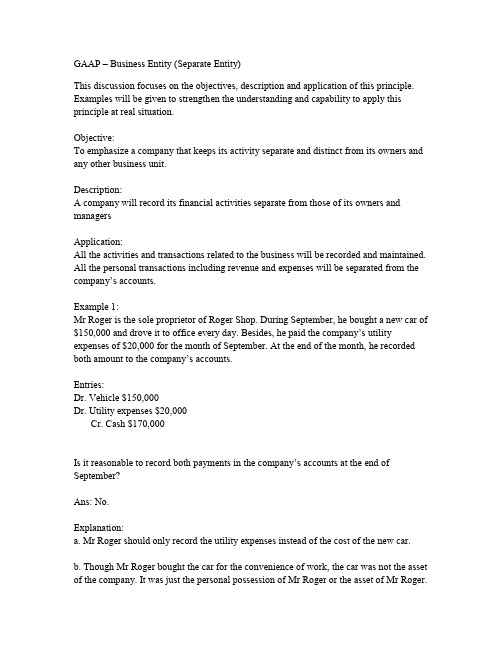
GAAP – Business Entity (Separate Entity)This discussion focuses on the objectives, description and application of this principle. Examples will be given to strengthen the understanding and capability to apply this principle at real situation.Objective:To emphasize a company that keeps its activity separate and distinct from its owners and any other business unit.Description:A company will record its financial activities separate from those of its owners and managersApplication:All the activities and transactions related to the business will be recorded and maintained. All the personal transactions including revenue and expenses will be separated from the company’s accounts.Example 1:Mr Roger is the sole proprietor of Roger Shop. During September, he bought a new car of $150,000 and drove it to office every day. Besides, he paid the company’s utility expenses of $20,000 for the month of September. At the end of the month, he recorded both amount to the company’s accounts.Entries:Dr. Vehicle $150,000Dr. Utility expenses $20,000Cr. Cash $170,000Is it reasonable to record both payments in the company’s accounts at the end of September?Ans: No.Explanation:a. Mr Roger should only record the utility expenses instead of the cost of the new car.b. Though Mr Roger bought the car for the convenience of work, the car was not the asset of the company. It was just the personal possession of Mr Roger or the asset of Mr Roger.Therefore, the cost of the new car should not be recorded in the c ompany’s account due to the separate entity concept.c. The utility expenses which include electricity, water and telecommunications are the expenses of the company in generating revenue. According to the ‘matching principle’, the amount should be recorde d in the company’s account.Example 2:Mr Roger is not only the owner of Roger Shop, he also works as a consultant in Wayne Corporation. Every month, he can receive a fixed amount of $10,000 as income from providing consulting services.At the end of September, he found that there is a loss of $8,000 in the income statement of Roger Shop. However, he did not like any loss shown in the financial statements so he just transferred the amount of income earned in Wayne Corp as revenue of Roger Shop. In this way, there would be no loss shown in the income statement. Instead, there was even a profit of $2,000.Should Mr Roger transfer the income of $10,000 to the income statement in order to change the loss to profit?Ans: NoExplanation:a. According to Busi ness entity, Mr Roger’s personal income should not be counted as one source of revenue for the Roger Shop.b. If the amount of $10,000 is added to the income statement, it will go against the‘matching principle’ since the revenue cannot be matched with t he expenses.c. If Mr Roger does not want to show the loss in the income statement, it will go against the ‘true and fair’ principle which means that the information of the financial statement is not reliable and wrong decision making will be resulted.Conclusion:No matter income or expenses, don’t count them in the company’s financial statement if they are the owner’s personal transactions. Remember that all the activities of an entity have to be separated from individual owners’ activities.。
会计五大原则-概述说明以及解释
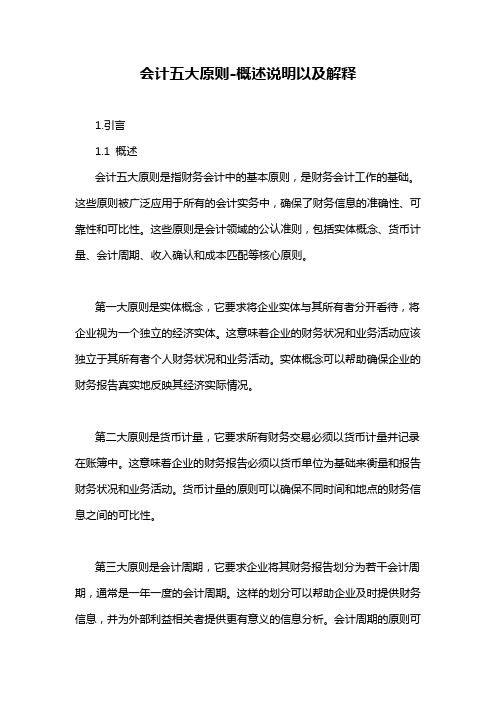
会计五大原则-概述说明以及解释1.引言1.1 概述会计五大原则是指财务会计中的基本原则,是财务会计工作的基础。
这些原则被广泛应用于所有的会计实务中,确保了财务信息的准确性、可靠性和可比性。
这些原则是会计领域的公认准则,包括实体概念、货币计量、会计周期、收入确认和成本匹配等核心原则。
第一大原则是实体概念,它要求将企业实体与其所有者分开看待,将企业视为一个独立的经济实体。
这意味着企业的财务状况和业务活动应该独立于其所有者个人财务状况和业务活动。
实体概念可以帮助确保企业的财务报告真实地反映其经济实际情况。
第二大原则是货币计量,它要求所有财务交易必须以货币计量并记录在账簿中。
这意味着企业的财务报告必须以货币单位为基础来衡量和报告财务状况和业务活动。
货币计量的原则可以确保不同时间和地点的财务信息之间的可比性。
第三大原则是会计周期,它要求企业将其财务报告划分为若干会计周期,通常是一年一度的会计周期。
这样的划分可以帮助企业及时提供财务信息,并为外部利益相关者提供更有意义的信息分析。
会计周期的原则可以确保财务报告的及时性和连贯性。
第四大原则是收入确认,它要求企业将收入确认为实现或可实现的经济利益,并与其相应的费用进行匹配。
这意味着企业在确认收入时必须考虑其收入来源的可靠性和确定性,并将相关的成本和费用与该收入相匹配。
收入确认的原则可以确保财务报告反映企业的真实业务表现。
第五大原则是成本匹配,它要求企业将相关的成本与其相应的收入进行匹配。
这意味着企业在确认成本和费用时必须考虑其与相应收入的关联性,并将其进行合理分配。
成本匹配的原则可以确保财务报告反映企业在特定会计周期内的真实经济状况。
这些会计五大原则可以帮助企业建立起一套规范化的财务会计制度,提高财务报告的可信度和可比性。
它们在保证企业财务信息的准确性和可靠性方面起着重要作用,并为企业经营决策和外部利益相关者提供了有用的参考依据。
在接下来的文章中,我们将详细探讨每个原则的含义和重要性。
2审计认定与目标习题及答案

第四章审计认定与目标练习题-S单项选择题1、下列爭项属权利和义务认定的有(A、注册会讣师在审資固定资产时发现账面列示小汽一台•其行驶记录的位名称与被审ii遵位名称不符.管理+局不能做出合理解释B、被审i|遵位将2001年12〃28日付出的购货款拖延至2002年1刀6日入账C.经检直入库飛和资产负债表日后收到购货发票等确认一笔应付账歎为90万元而非95万元。
D.注册会讣师发现被审il•敢位虚列应收账款200万元2、注册会计师在审査应收账款时.发现帐上某笔记录伽应收厳款一A公司100万元,贷:主营业务收入100万元S通过函证A公司、检查销货记录证实• A公司实际欠款60万元,对方多汁销售数虽40%。
那么.管理H局的()认定存在问题。
A、存在或发生8.完整性C.估价或分摊0、表达与披露3、下列各项中.被审讣爪位()违反了权利和义务认定和表达与披露的认定•A、未将作为抵押物的房屋披露B、将未发生的销售登记入账C.将未发生的费用登记入账D、未汁提坏账准备4、在接受审讣业务委托前,后任注册会il师应向前任注册会计师了解()。
A、审计重要性水平B、函证回函情况C.存货盘点计划0.企业管理十局的品行5、注册会il•师在审査销售业务时.发现被审讣敢位某笔销售记录50万元,通过检査销皆记录、函证等实质性测试程序证实.该笔销售实际取御收入900万元.那么管理严I局的()认定存在问题。
A、存在或发生 B.权利或义务C、估价或分摊D.表达与披爲E.完整性6、下列各项中()违反r权利和义务的认定。
A、将未曾发生的销售提前入账B、将已发生的销售业务不登记入账C.未将已抵押的存货披露D、待瘵费用摊销期限不恰片7・管理艸局对会il•报表的下列认定中.注册会计师通过分析存货周转率报有可能证实的是()•存在或发生B・权利和义务C •表达和披霧0 •估价或分摊下列()是为r实现注册会讣师一般审计目标中的截止目标。
A •年前开出的支票是否均在年前入账B・预付账歎是否真实C •存货的跌价损失是否已经抵减D •存货是否有充作抵押下列审计程序或概念•()必须运用在审计实施阶段。
会计准则——基本会计准则
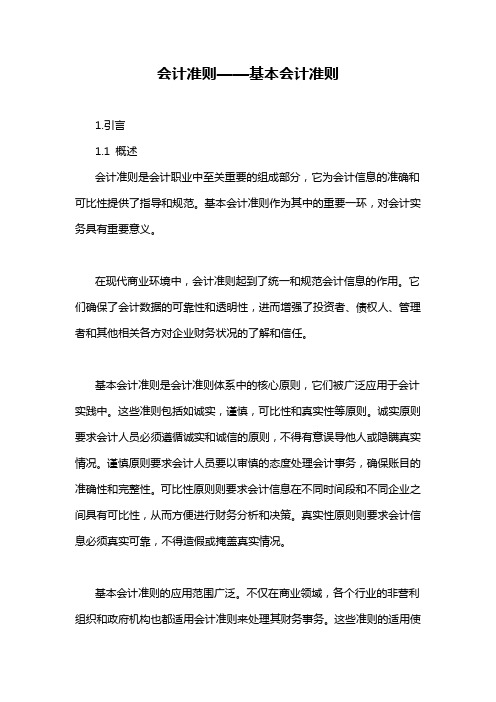
会计准则——基本会计准则1.引言1.1 概述会计准则是会计职业中至关重要的组成部分,它为会计信息的准确和可比性提供了指导和规范。
基本会计准则作为其中的重要一环,对会计实务具有重要意义。
在现代商业环境中,会计准则起到了统一和规范会计信息的作用。
它们确保了会计数据的可靠性和透明性,进而增强了投资者、债权人、管理者和其他相关各方对企业财务状况的了解和信任。
基本会计准则是会计准则体系中的核心原则,它们被广泛应用于会计实践中。
这些准则包括如诚实,谨慎,可比性和真实性等原则。
诚实原则要求会计人员必须遵循诚实和诚信的原则,不得有意误导他人或隐瞒真实情况。
谨慎原则要求会计人员要以审慎的态度处理会计事务,确保账目的准确性和完整性。
可比性原则则要求会计信息在不同时间段和不同企业之间具有可比性,从而方便进行财务分析和决策。
真实性原则则要求会计信息必须真实可靠,不得造假或掩盖真实情况。
基本会计准则的应用范围广泛。
不仅在商业领域,各个行业的非营利组织和政府机构也都适用会计准则来处理其财务事务。
这些准则的适用使得不同实体的财务报表能够进行比较和分析,提高了财务信息的可靠性和可用性。
综上所述,基本会计准则作为会计准则体系的核心部分,在现代商业环境中扮演着重要的角色。
它们的正确应用能够增加会计信息的准确性和可比性,提高信任度,从而促进经济发展和企业的可持续发展。
文章结构是指文章的组织框架和逻辑流程。
一个良好的文章结构可以帮助读者更好地理解文章的内容,并使文章的逻辑更加清晰和有条理。
本文为了解释会计准则的基本概念和应用范围,文章结构如下所示:1. 引言1.1 概述引言部分将介绍会计准则的基本概念和内容,以及为什么会计准则对于会计信息的编制和财务报表的准确性非常重要。
此外,还可以提及基本会计准则的制定机构和参与者。
1.2 文章结构本节将介绍文章的整体结构和各个章节的内容安排。
通过这一节,读者可以了解到整篇文章的逻辑流程和组织结构,有助于他们更好地理解文章的内容。
美国 GAAP 下的企业财务报表分析与投资决策
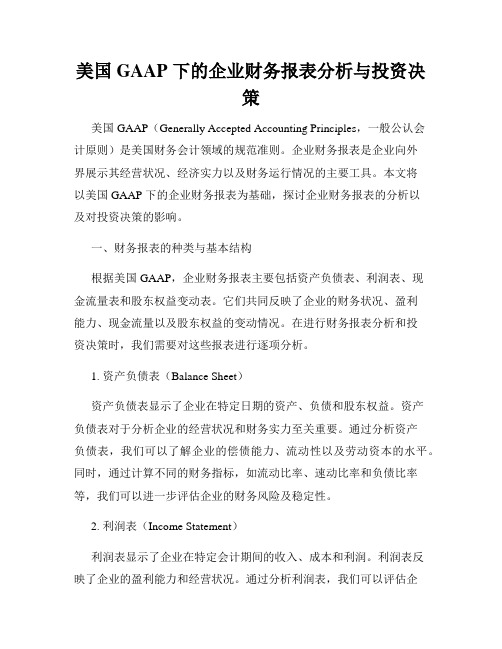
美国 GAAP 下的企业财务报表分析与投资决策美国 GAAP(Generally Accepted Accounting Principles,一般公认会计原则)是美国财务会计领域的规范准则。
企业财务报表是企业向外界展示其经营状况、经济实力以及财务运行情况的主要工具。
本文将以美国 GAAP 下的企业财务报表为基础,探讨企业财务报表的分析以及对投资决策的影响。
一、财务报表的种类与基本结构根据美国 GAAP,企业财务报表主要包括资产负债表、利润表、现金流量表和股东权益变动表。
它们共同反映了企业的财务状况、盈利能力、现金流量以及股东权益的变动情况。
在进行财务报表分析和投资决策时,我们需要对这些报表进行逐项分析。
1. 资产负债表(Balance Sheet)资产负债表显示了企业在特定日期的资产、负债和股东权益。
资产负债表对于分析企业的经营状况和财务实力至关重要。
通过分析资产负债表,我们可以了解企业的偿债能力、流动性以及劳动资本的水平。
同时,通过计算不同的财务指标,如流动比率、速动比率和负债比率等,我们可以进一步评估企业的财务风险及稳定性。
2. 利润表(Income Statement)利润表显示了企业在特定会计期间的收入、成本和利润。
利润表反映了企业的盈利能力和经营状况。
通过分析利润表,我们可以评估企业的销售业绩、毛利率、净利润率以及其他关键财务指标。
此外,对于投资者来说,利润表还提供了企业分红和利润分配的信息,这对投资决策有重要影响。
3. 现金流量表(Cash Flow Statement)现金流量表展示了企业特定会计期间的现金流入和流出情况。
通过分析现金流量表,我们可以了解企业的现金流动性及其对现金的管理能力。
现金流量表在投资决策中起着重要作用,因为投资者关注企业的现金流量情况,以确定企业的现金收益能力和偿债能力。
4. 股东权益变动表(Statement of Shareholders' Equity)股东权益变动表显示了企业特定会计期间内股东权益的变动情况。
GAAP_Accrual Principle 一般公认会计原则
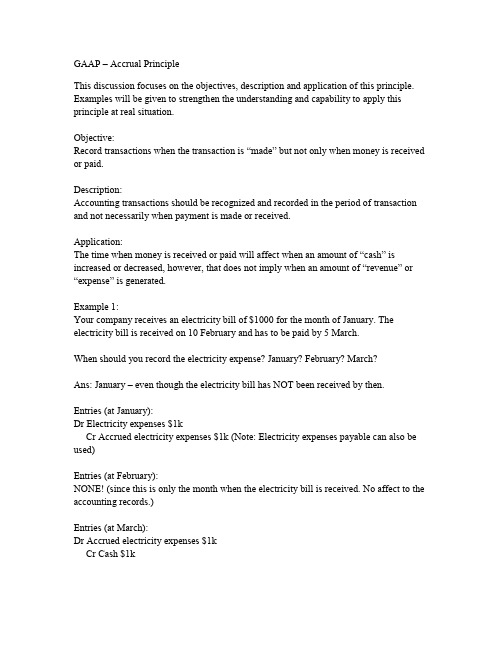
GAAP – Accrual PrincipleThis discussion focuses on the objectives, description and application of this principle. Examples will be given to strengthen the understanding and capability to apply this principle at real situation.Objective:Record transactions when the transaction is “made” but not only when money is received or paid.Description:Accounting transactions should be recognized and recorded in the period of transaction and not necessarily when payment is made or received.Application:The time when money is received or paid will affect when an amount of “cash” is increased or decreased, however, that does not imply when an amount of “revenue” or “expense” is generated.Example 1:Your company receives an electricity bill of $1000 for the month of January. The electricity bill is received on 10 February and has to be paid by 5 March.When should you record the electricity expense? January? February? March?Ans: January – even though the electricity bill has NOT been received by then.Entries (at January):Dr Electricity expenses $1kCr Accrued electricity expenses $1k (Note: Electricity expenses payable can also be used)Entries (at February):NONE! (since this is only the month when the electricity bill is received. No affect to the accounting records.)Entries (at March):Dr Accrued electricity expenses $1kCr Cash $1kExplanation:a) Though the electricity bill has not yet received but the amount of $1k electricity expenses is used during the period of January, therefore, according to the “matching principle”, this amount should be recorded at the month when the revenue generated by this expenses is made (Note: Your company uses electricity to operate and through operation, revenue should be generated. Therefore, the electricity expense is actually the amount of expenses that helps your company to generate revenue.)b) However, since money has NOT been paid, there is NO reduction in cash. (i.e. cannot Cr Cash!). It can only be recorded as a cash outflow by March – when the amount is “paid”.c) This amount of “unpaid” expenses will be treated as an amount of “Liabilities” (i.e. Accrued electricity expenses / Electricity expenses payable)d) How do we know the amount to record in February before we receive the electricity bill?- Either through forecast; or- Through adjustmentExample 2:Your company has sold concert tickets and received $2,000 cash. The concert will take place by next month – February.Entries (at January):Dr Cash $2kCr Accrued concert revenue $2kEntries (at February):Dr Accrued concert revenue $2kCr Concert revenue $2kExplanation:a) Though money has been received in January, however, since services (i.e. the concert) has not been provided, therefore, according to the “realization principle”, you cannot record any “revenue”.b) Consequently, you can only record the amount as “Accrued concert revenue”, an amount of “liabilities”, which your company has to rep ay (through provision of services)in the future.c) When the services are rendered, again according to the “realization principle”, an amount of “revenue” should be recorded. By then, you can change the amount of “liabilities” to “revenue”.。
- 1、下载文档前请自行甄别文档内容的完整性,平台不提供额外的编辑、内容补充、找答案等附加服务。
- 2、"仅部分预览"的文档,不可在线预览部分如存在完整性等问题,可反馈申请退款(可完整预览的文档不适用该条件!)。
- 3、如文档侵犯您的权益,请联系客服反馈,我们会尽快为您处理(人工客服工作时间:9:00-18:30)。
13-15
IAS
16.不動產、廠房及設備 17.租賃 18.收入 19.員工福利 20.政府補助之會計及政府輔助之揭露 21.匯率變動之影響
會計學 Chapter 13 一般公認會計原則
13-16
IAS
23.借款成本 24.關係人揭露 26.退休福利計劃之會計與報導 27.合併及單獨財務報表 28.投資關聯企業 29.高度通貨膨脹經濟下之財務報表
會計學 Chapter 13 一般公認會計原則
13-10
會計理論的基礎
16. 財務預測編製要點 17. 現金流量表 18. 退休金會計處理準則 19. 創業期間會計處理準則 22. 所得稅之會計處理準則 23. 期中財務報表之表達與揭露 24. 每股盈餘
會計學 Chapter 13 一般公認會計原則
台灣國際會計準則
我國採用國際會計準則IFRSs ,以直接採用方式,即 直接逐號翻譯國際會計準則,稱為台灣國際會計準則 (Taiwan IFRSs 簡寫TIFRS) 。
會計學 Chapter 13 一般公認會計原則
13-22
第四節 基本環境假設
權責發生基礎:企業應採權責發生基礎編製財務報告。 繼續經營慣假設:假設企業會持續經營下去。
會計學 Chapter 13 一般公認會計原則
13-19
IFRS
1. 首次採用國際財務報導準則 2. 股份基礎給付 3. 企業合併 4. 保險合約 5. 待出售非流動資產及停業單位 6. 礦產資源探勘及評估 7. 金融工具:揭露 8. 營運部門 9. 金融工具
會計學 Chapter 13 一般公認會計原則
會計學 Chapter 13 一般公認會計原則
13-17
I表達 33.每股盈餘 34.期中財務報導 36.資產減損
會計學 Chapter 13 一般公認會計原則
13-18
IAS
37.負債準備、或有負債及或有資產 38.無形資產 39.金融工具:認列與衡量 40.投資性不動產 41.農業 空號為已被取代失效公報
會計學 Chapter 13 一般公認會計原則
13-13
第三節 國際會計準則
IAS IFRS
會計學 Chapter 13 一般公認會計原則
13-14
IAS
1.財務報表之表達 2.存貨 7.現金流量表 8.會計政策、會計估計變動及錯誤 10.報導期間後事項 11. 建造合約 12.所得稅
會計學 Chapter 13 一般公認會計原則
13-3
可瞭解性
指財務報表提供的資訊須簡單易懂。 財務資訊服務的對象範圍教育及經驗背景不同,所以 在提供財務資訊及制定會計科目時,應簡單易懂不要 過份生澀,才能使得財務資訊具有良好的特質。
會計學 Chapter 13 一般公認會計原則
13-4
攸關性
指財務報表提供的資訊必須與決策有關。
預測價值:能提供未來預測資訊 回饋價值:能證實或更正以前預測 時效性:能在決策前提供資訊
13-11
會計理論的基礎
25. 企業合併---購買法之會計處理 28. 銀行財務報表之揭露 29. 政府輔助之會計處理準則 30. 庫藏股票會計處理準則 31. 合資投資之會計處理準則 32. 收入認列之會計處理準則 33. 金融資產之移轉及負債消滅之會計處理
會計學 Chapter 13 一般公認會計原則
13-12
會計理論的基礎
34. 金融商品之會計處理準則 35. 資產減損之會計處理準則 36. 金融商品之表達與揭露 37. 無形資產之會計處理準則 38. 待出售非流動資產及停業單位之會計處理準則 39. 股份基礎給付之會計處理準則 40. 保險合約之會計處理準則 41. 營運部門之揭露 4. 13.20.21. 26.27.四號公報已被其他公報取代
會計學 Chapter 13 一般公認會計原則
13-23
第五節 收入認列原則
收入通常於已實現或可實現且已賺得時認列,下列四 項條件全部符合時,方宜認列收入已實現或可實現, 而且已賺得: 1. 具有說服力之證據證明雙方交易存在。 2. 商品已交付且風險及報酬已移轉,勞務已提供或
號次 公
報
名
稱
1 . 財務會計觀念架構及財務報表之編製
2. 租賃會計處理準則
3. 利息資本化會計準則
5. 採權益法之長期股權投資會計處理準則
6. 關係人交易之揭露
7. 合併財務報表
會計學 Chapter 13 一般公認會計原則
13-9
會計理論的基礎
8. 會計變動及前期損益調整之處理準則 9. 或有事項及期後事項之處理準則 10. 存貨之會計處理準則 11. 長期工程合約之會計處理準則 12. 所得稅抵減之會計處理準則 14. 外幣換算之會計處理準則 15. 會計政策之揭露
一般公認會計原則
第一節 財務報表的目的 第二節 會計理論的基礎 第三節 國際會計準則 第四節 基本環境假設 第五節 收入認列原則
會計學 Chapter 13 一般公認會計原則
13-2
第一節 財務報表的目的
依一般公認會計原則編製,主要提供外部使用者參考。 應具備:
可瞭解性 攸關性 可靠性 比較性
會計學 Chapter 13 一般公認會計原則
會計學 Chapter 13 一般公認會計原則
13-5
可靠性
指財務報表所提供的資訊能免於錯誤與偏差,並能忠 實表達所代表的經濟現象。
忠實表達:表達與事實相符 可驗證性:由他人以相同方法處理結果相同 中立性:不操縱財務報表圖利特定人
會計學 Chapter 13 一般公認會計原則
13-6
比較性
指財務報表前後期應能比較,因此採用的會計方法必 須具有一貫性。 資訊使用者利用已發生的歷史趨勢,來推論未來可能 發生的情況。
會計學 Chapter 13 一般公認會計原則
13-7
第二節 會計理論的基礎
一般公認會計原則的定義及重要性 會計原則發布機構
會計研究發展基金會 證期局 美國會計師協會 美國財務會計準則委員會 美國會計學會 國際會計準則委員會
會計學 Chapter 13 一般公認會計原則
13-8
會計理論的基礎
我國已發布會計原則
13-20
我國採用國際會計準則
我國上市、上櫃及興櫃公司,自2013年起依IFRSs編 製財務報告。 非上市、上櫃及興櫃之公開發行公司,應自2015年起 依依IFRSs編製財務報告。 非公開發行公司,則仍按商業會計法及我國公認會計 原則編製財務報告。
會計學 Chapter 13 一般公認會計原則
13-21
